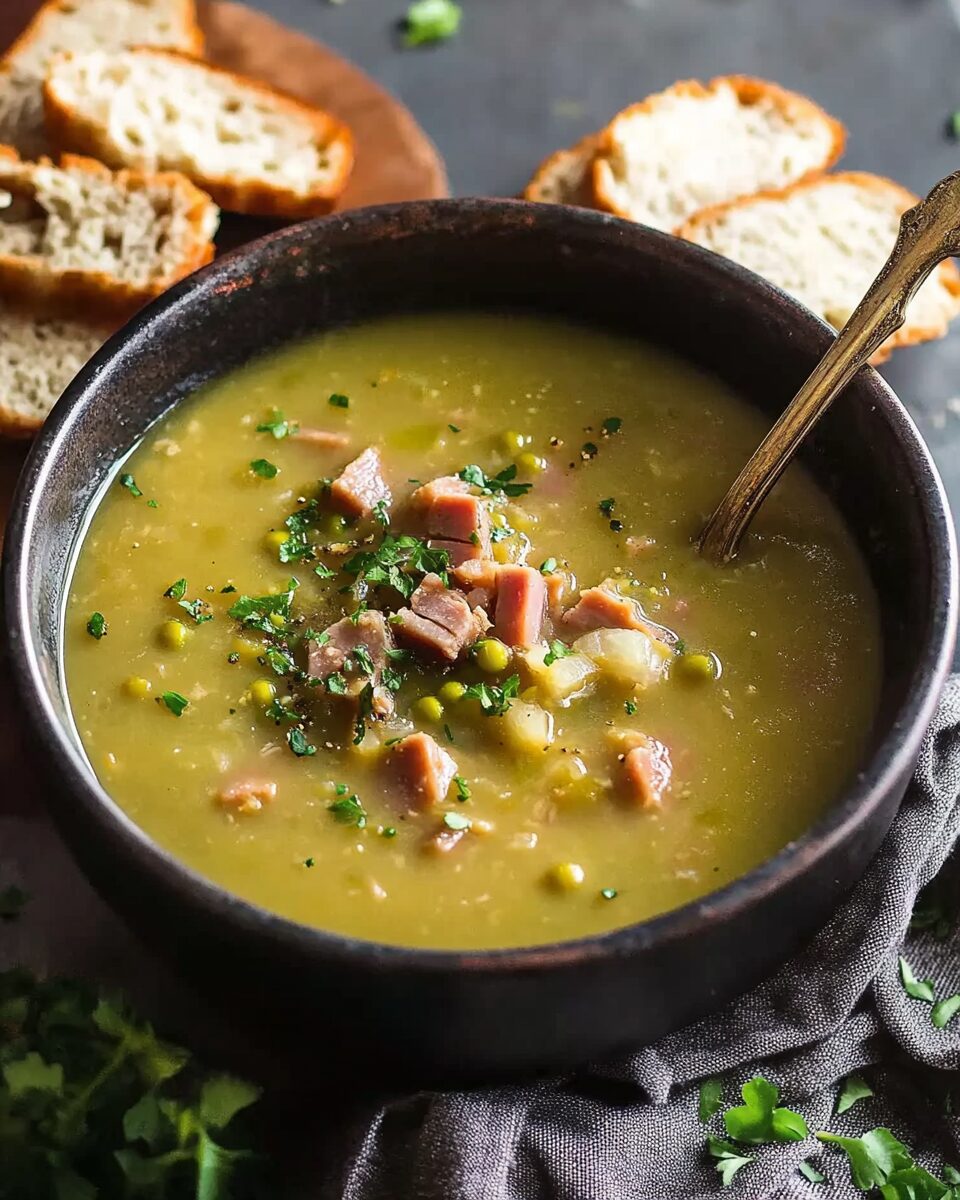The ultimate cold-weather classic, Pea and Ham Soup is a rich and hearty dish that’s been warming hearts for generations. The secret to its deep, savory flavor lies in the smoked ham hock, which infuses every spoonful with irresistible richness. Paired with split peas that melt into a velvety base and simple aromatics like onion, carrot, and celery, it’s a one-pot wonder you’ll want to make over and over. Whether you’re craving a nourishing midweek meal or planning to meal-prep comforting lunches, this soup ticks all the boxes. It’s budget-friendly, loaded with nutrients, and gets better with time, making it ideal for batch cooking. Serve with crusty bread or toasted sourdough for the ultimate experience.
Full Recipe:
Ingredients:
-
1 tbsp olive oil
-
1 onion, chopped
-
2 garlic cloves, minced
-
2 carrots, chopped
-
2 celery sticks, chopped
-
1 bay leaf
-
1 smoked ham hock
-
1 lb dried split green peas, rinsed
-
8 cups water
-
Salt and pepper to taste
Directions:
-
Heat olive oil in a large pot over medium heat. Add onion and garlic, sauté for 2-3 minutes until translucent.
-
Add carrots and celery, cook for another 5 minutes, stirring occasionally.
-
Place the ham hock into the pot and add the split peas, bay leaf, and water. Bring to a boil.
-
Reduce heat and simmer uncovered for 1.5 to 2 hours, stirring occasionally, until the peas have broken down and the soup is thickened.
-
Remove the ham hock, shred the meat, and discard the bone and skin. Return shredded ham to the soup.
-
Season with salt and pepper to taste. Simmer for 10 more minutes before serving.
Prep Time: 10 minutes | Cooking Time: 2 hours | Total Time: 2 hours 10 minutes
Kcal: 290 kcal | Servings: 6 servings
The Ultimate Comfort Dish: Pea and Ham Soup
Few dishes evoke the kind of cozy, satisfying nostalgia that Pea and Ham Soup delivers. With its creamy texture, smoky undertones, and heartwarming depth of flavor, this classic soup has become a staple in kitchens across the world especially when the weather turns cold. Derived from humble ingredients like split peas and smoked ham hock, Pea and Ham Soup has earned a place in culinary history for its simplicity, nourishment, and comforting nature. Whether served as a main meal with a side of crusty bread or as a starter at a winter dinner party, it remains one of the most beloved soups for generations.
The Origins and Tradition Behind Pea and Ham Soup
Pea and Ham Soup has a long-standing tradition that traces back to European peasant cooking. The earliest variations emerged in places like Britain, Germany, and the Netherlands, where families made the most of inexpensive, preserved ingredients. Smoked ham hock or ham bone was used to flavor broths while dried split peas provided sustenance, fiber, and texture.
This recipe is not only affordable but also a perfect example of the “waste not, want not” philosophy. Using every bit of the ham hock including meat clinging to the bone was a smart and economical way to stretch meals. Over time, Pea and Ham Soup gained popularity far beyond humble kitchens, making its way into restaurants and home cookbooks around the world.
Nutritional Value and Health Benefits
Pea and Ham Soup isn’t just flavorful it’s also packed with nutrients. Split peas are an excellent source of plant-based protein and dietary fiber, making them a powerful ingredient for digestive health and satiety. A single serving often provides more than half of your daily fiber needs, which is critical for gut health and maintaining balanced blood sugar levels.
The inclusion of smoked ham hock or shredded ham adds another layer of protein, making this dish especially satisfying. In addition to its protein content, ham contains B vitamins, particularly B6 and B12, which play a vital role in brain function and energy production.
While the soup has a hearty feel, it can be surprisingly low in fat especially if you skim any excess fat from the broth after cooking. It’s also gluten-free by nature, making it an excellent option for those with dietary restrictions. Paired with whole-grain bread or a fresh salad, this soup forms a well-rounded, nourishing meal.
Flavor Profile and Texture
What sets Pea and Ham Soup apart from other soups is its distinctive blend of flavors. The smokiness from the ham hock permeates every bite, infusing the peas with deep umami character. The base vegetables usually onion, garlic, carrot, and celery add aromatic sweetness and earthiness, perfectly balancing the salty richness of the ham.
As the split peas cook, they break down into a soft, creamy consistency that thickens the soup naturally without any need for cream or flour. This texture creates a velvety mouthfeel that clings lovingly to each spoonful. The final touch of shredded ham stirred back into the soup adds bursts of meaty texture and savory flavor.
Cooking Method: Why Slow and Low Works Best
A key characteristic of Pea and Ham Soup is the slow-cooking process. Allowing the ingredients to simmer gently for over an hour helps the flavors meld and develop a richness that simply can’t be rushed. The ham hock releases its essence into the broth while the split peas soften and dissolve, creating that signature creamy base.
Although it can be made on the stovetop, the recipe also adapts beautifully to slow cookers and pressure cookers. A slow cooker allows for hands-off cooking, ideal for busy days or batch cooking. An electric pressure cooker like an Instant Pot can deliver the same deep flavor in a fraction of the time about 30-40 minutes under high pressure. No matter the method, the result is a bowl full of comfort that can be enjoyed fresh or frozen for future meals.
Storage and Make-Ahead Tips
Pea and Ham Soup stores exceptionally well, making it a great candidate for meal prepping. In fact, the flavor often deepens after a day or two in the fridge, as the ingredients continue to marry. When stored in an airtight container in the refrigerator, it stays fresh for up to 4–5 days.
It also freezes beautifully. Just cool the soup completely before portioning into freezer-safe containers. It will keep for up to 3 months. When ready to eat, simply reheat on the stovetop or in the microwave, adding a splash of water or broth to loosen the consistency if it has thickened.
Serving Suggestions and Pairings
Pea and Ham Soup is hearty enough to be served as a meal on its own, but a few additions can elevate the experience:
-
Crusty Bread: A slice of sourdough, rye, or rustic country loaf complements the soup’s creamy texture.
-
Croutons or Toasted Seeds: For extra crunch, top with homemade croutons or pumpkin seeds.
-
Herbs: Fresh parsley, thyme, or a touch of cracked black pepper can brighten and enhance the flavors.
-
Salad: A simple side salad with lemon vinaigrette adds contrast and freshness to the richness of the soup.
It also pairs wonderfully with a dry white wine like Sauvignon Blanc, which cuts through the soup’s richness, or even a pint of stout for a more rustic experience.
Customizations and Variations
One of the most appealing aspects of Pea and Ham Soup is its adaptability. While the traditional recipe holds its own, there are plenty of ways to tweak the soup based on personal preferences or dietary needs:
-
Vegetarian Version: Skip the ham and use vegetable broth. Add smoked paprika or a dash of liquid smoke for that deep, smoky flavor.
-
Spicy Kick: Add red pepper flakes or a chopped chili to give the soup a warming spice.
-
Herb-Infused: Experiment with bay leaves, thyme, or rosemary for a more herbaceous profile.
-
Creamy Finish: Blend the soup until smooth and stir in a splash of cream or coconut milk for an indulgent texture.
-
Chunky Style: Reserve a portion of cooked vegetables and ham before blending to add back for a chunkier consistency.
A Dish with Seasonal and Cultural Appeal
Pea and Ham Soup shines particularly bright during the cooler months. It’s a perfect winter warmer, ideal for those chilly nights when all you want is a bowl of something hot, hearty, and homemade. But it also holds cultural significance in places like the UK, Australia, and Scandinavian countries, where it’s often featured in family gatherings, holiday dinners, and even school lunches.
Advertisement
In Sweden, for instance, a version called “ärtsoppa” is traditionally eaten on Thursdays with pancakes for dessert. In England, the soup often appears alongside crusty bread or as part of a pub lunch menu. Its timeless appeal continues to transcend regions and generations.
Conclusion:
Pea and Ham Soup is more than just a meal it’s a culinary tradition rooted in simplicity, economy, and comfort. Its nourishing properties, rich flavor profile, and versatile nature make it a go-to dish for both novice home cooks and seasoned chefs. Whether you’re making it as part of a weekly meal prep, serving it to loved ones on a cold winter’s night, or introducing it to a new audience on your food blog, this soup embodies the heart of home cooking.
From its humble origins to its spot in modern cookbooks, Pea and Ham Soup proves that a few simple ingredients, when treated with care, can come together to create something deeply satisfying and soul-warming. It’s a recipe worth revisiting, a dish worth sharing, and a tradition worth keeping alive.

